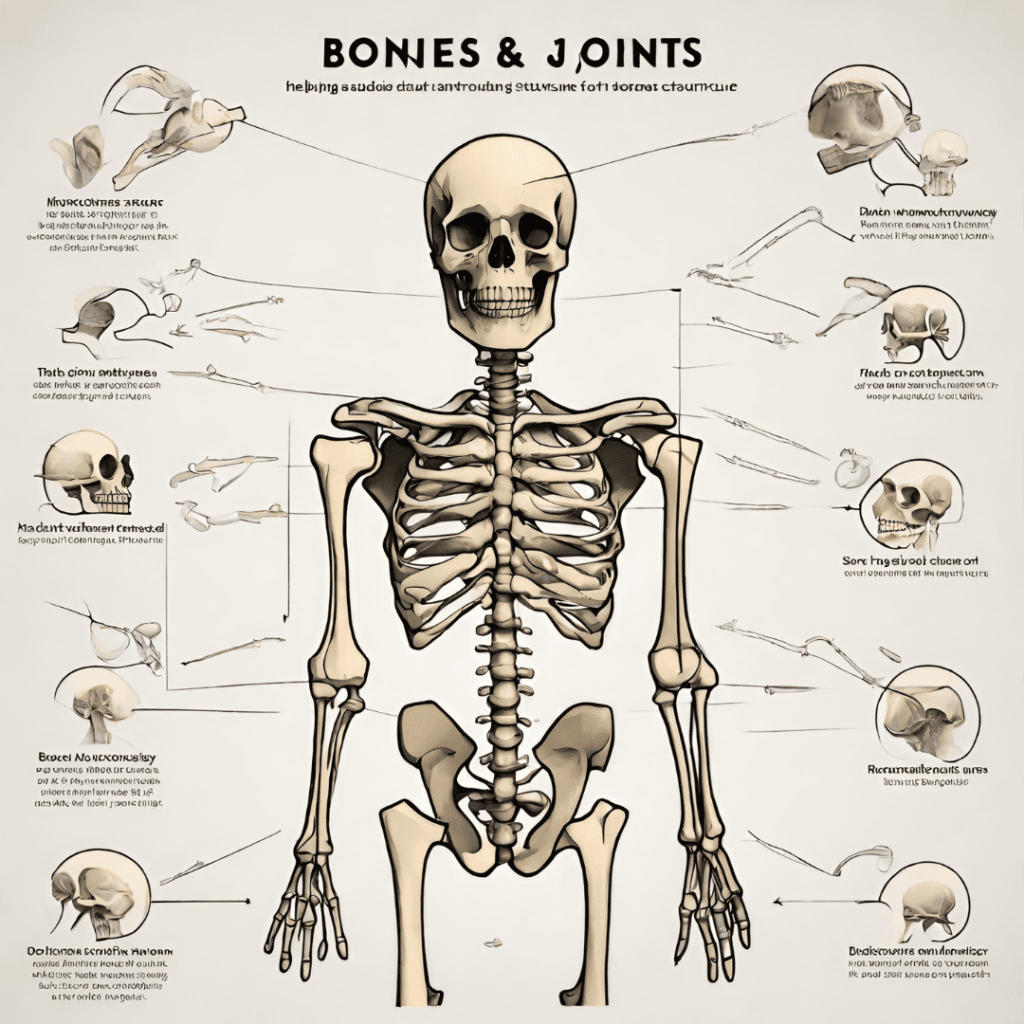Great Health Great Fitness
“Bone and Joint Health: Building Resilient Foundations – A Comprehensive Guide”
In the quest for optimal health, strong bones and joints are foundational. "Bone and Joint Health: Building Resilient Foundations" serves as a compass in this journey, offering insights and strategies to fortify these vital structures. From understanding their anatomy to recognizing symptoms and living well despite challenges, this comprehensive guide empowers individuals to nurture their musculoskeletal health for a vibrant life.

Introduction
Bone and joint health are fundamental aspects of overall well-being, contributing to our ability to move, perform daily tasks, and maintain independence. Strong bones provide structural support and protect vital organs, while healthy joints facilitate smooth movement and flexibility. However, maintaining optimal bone and joint health is not automatic; it requires proactive care, attention, and awareness of potential risk factors.
In this comprehensive guide, we will delve into the importance of bone and joint health, explore the anatomy of bones and joints, discuss common conditions that affect them, and provide practical strategies for promoting and preserving bone and joint health throughout life. Whether you are young or old, active or sedentary, understanding and prioritizing bone and joint health is essential for living a full and active life free from pain and mobility limitations.
Join us on this journey to learn more about how you can build and maintain strong foundations for bone and joint health, empowering yourself to enjoy a lifetime of movement, vitality, and well-being.
Understanding Bone and Joint Anatomy

To appreciate the importance of bone and joint health, it’s essential to understand the intricate anatomy of these vital structures.
1. Bones:
This is form the framework of the body, providing support, protection, and structure. They are composed of living tissue that constantly undergoes remodeling, a process of old bone being removed and new bone being formed. Key components of bones include:
- Compact Bone: This dense outer layer of bone provides strength and protection.
- Spongy Bone: Also known as trabecular bone, this porous inner layer contains bone marrow and is involved in blood cell production.
- Bone Marrow: Found within the cavities of bones, bone marrow is responsible for producing blood cells, including red blood cells, white blood cells, and platelets.
- Bone Cells: Various types of bone cells, including osteoblasts (bone-forming cells), osteoclasts (bone-resorbing cells), and osteocytes (mature bone cells), work together to maintain bone structure and function.
2. Joints:
They are the connections between bones, allowing for movement and flexibility. They come in various types, each serving a specific purpose:
- Synovial Joints: These freely movable joints are the most common type in the body and include hinge joints (e.g., knees and elbows), ball-and-socket joints (e.g., hips and shoulders), and pivot joints (e.g., neck).
- Cartilaginous Joints: These joints are connected by cartilage and provide limited movement, such as the joints between the vertebrae in the spine.
- Fibrous Joints: These immovable joints are connected by fibrous tissue and provide stability and support, such as the sutures in the skull.
3. Ligaments and Tendons:
Ligaments and tendons are connective tissues that play crucial roles in supporting and stabilizing joints:
- Ligaments: These tough bands of fibrous tissue connect bones to bones, providing stability and preventing excessive movement.
- Tendons: These tough cords of fibrous tissue connect muscles to bones, transmitting the force generated by muscles to produce movement.
Understanding the anatomy of bones and joints provides insight into their function and the importance of maintaining their health and integrity. By nurturing these vital structures through proper nutrition, exercise, and preventive care, we can promote lifelong bone and joint health and enhance overall well-being.
Risk Factors and Causes
Effective management of this and joint conditions begins with understanding their underlying causes and risk factors. For osteoporosis, factors such as aging, hormonal changes, inadequate calcium and vitamin D intake, sedentary lifestyle, smoking, and excessive alcohol consumption can increase the risk. Similarly, arthritis risk factors may include genetics, age, obesity, joint injuries, and autoimmune disorders. Understanding these risk factors can help individuals take proactive steps to reduce their likelihood of developing these conditions.
Risk factors are diverse and multifactorial, encompassing a myriad of genetic, environmental, lifestyle, and medical contributors that predispose individuals to the development of bone and joint conditions. Genetic predisposition plays a significant role, with certain genetic variants increasing susceptibility to conditions such as osteoporosis and rheumatoid arthritis. Environmental factors, including exposure to pollutants, toxins, and radiation, can also heighten risk, highlighting the importance of environmental awareness and mitigation efforts.
Lifestyle choices exert a profound influence on bone and joint health, with modifiable risk factors such as poor nutrition, sedentary behavior, smoking, and excessive alcohol consumption contributing to increased susceptibility to conditions such as osteoporosis, osteoarthritis, and musculoskeletal injuries. The adoption of a healthy lifestyle characterized by regular physical activity, balanced nutrition, smoking cessation, and moderate alcohol consumption can mitigate these risks and promote optimal bone and joint health.
Medical conditions and treatments can also influence susceptibility and joint conditions. Chronic conditions such as diabetes, inflammatory bowel disease, and autoimmune disorders are associated with an elevated risk of osteoporosis and arthritis, underscoring the importance of comprehensive management and targeted interventions in individuals with these comorbidities. Additionally, certain medications, such as corticosteroids and anticonvulsants, can adversely affect bone health, necessitating close monitoring and proactive measures to mitigate potential side effects.
Unraveling Underlying Causes: Deciphering the Pathways to Disease
Beyond risk factors, understanding the underlying causes and joint conditions is essential for targeted intervention and disease management. Osteoporosis, for example, is characterized by decreased bone density and strength, resulting from an imbalance between bone formation and resorption processes. Contributing factors include age-related hormonal changes, inadequate calcium and vitamin D intake, hormonal imbalances, and medical conditions such as hyperparathyroidism and hyperthyroidism.
Arthritis encompasses a spectrum of conditions characterized by joint inflammation, cartilage degradation, and progressive joint damage. Osteoarthritis, the most common form, results from the wear and tear of joint cartilage over time, exacerbated by factors such as aging, obesity, joint injury, and genetic predisposition. Rheumatoid arthritis, on the other hand, is an autoimmune disorder characterized by systemic inflammation and joint destruction, driven by aberrant immune responses targeting the synovial membrane.
Traumatic injuries, such as fractures and ligament tears, represent acute causes of bone and joint conditions, often resulting from accidents, falls, or sports-related activities. These injuries can have long-term implications for joint function and mobility, highlighting the importance of injury prevention strategies and rehabilitation efforts.
Infectious agents, such as bacteria and viruses, can also contribute to bone and joint conditions through the development of septic arthritis or osteomyelitis, necessitating prompt diagnosis and targeted antimicrobial therapy.
Recognizing Symptoms

Early recognition of symptoms is crucial for timely intervention and management of bone and joint conditions. Symptoms may vary depending on the specific condition but can include pain, swelling, stiffness, decreased range of motion, and difficulty performing daily activities. It’s essential for individuals to pay attention to changes in their bodies and seek medical attention if they experience persistent or worsening symptoms. Diagnosing bone and joint conditions typically involves a combination of medical history, physical examination, imaging tests (such as X-rays, MRI, or CT scans), and laboratory tests (such as blood tests or joint fluid analysis).
Treatment Options
Treatment options for bone and joint conditions vary depending on the specific diagnosis, severity of symptoms, and individual needs. In many cases, treatment aims to relieve pain, reduce inflammation, improve joint function, and prevent further damage. Non-pharmacological interventions may include lifestyle modifications, such as weight management, exercise, and physical therapy. Medications such as analgesics, anti-inflammatory drugs, disease-modifying antirheumatic drugs (DMARDs), and biologic agents may be prescribed to manage symptoms and slow disease progression. In some cases, surgical interventions, such as joint replacement or fracture repair, may be necessary to restore function and alleviate pain.
Living Well with Bone and Joint Conditions
Living well with bone and joint conditions requires a multidisciplinary approach that addresses physical, emotional, and social aspects of health. Engaging in regular physical activity, maintaining a healthy diet, managing stress, and getting adequate rest can help support overall well-being. It’s also essential for individuals to communicate openly with their healthcare providers, adhere to treatment plans, and participate actively in their care. Support from family, friends, and support groups can provide invaluable encouragement and assistance in navigating the challenges associated with bone and joint conditions. By adopting a proactive approach to management and making informed lifestyle choices, individuals can optimize their quality of life and maintain independence despite the challenges posed by bone and joint conditions.
Effective communication with healthcare providers is fundamental in the management of bone and joint conditions. Open dialogue allows for the exchange of valuable information, facilitates shared decision-making, and ensures that treatment plans are tailored to individual needs and preferences. Adhering to prescribed medications, therapies, and follow-up appointments is crucial for achieving optimal outcomes.
Furthermore, active involvement in one’s own care is key to success. Empowering individuals to take charge of their health by understanding their condition, seeking out relevant resources and information, and actively participating in treatment decisions can foster a sense of control and autonomy.
Beyond medical interventions, social support plays a pivotal role in coping with the challenges associated with bone and joint conditions. Family, friends, and support groups can provide emotional encouragement, practical assistance, and valuable insights based on shared experiences. Connecting with others who understand the journey can offer comfort, validation, and a sense of belonging.
By embracing a proactive approach to management and making informed lifestyle choices, individuals can optimize their quality of life and maintain independence despite the hurdles posed by bone and joint conditions. Empowerment through knowledge, self-care, and social support lays the groundwork for resilience and well-being in the face of adversity. For More Information you can check our blogs “Celiac Disease: Triumphing Over Gluten Sensitivity for Vibrant Health”.
